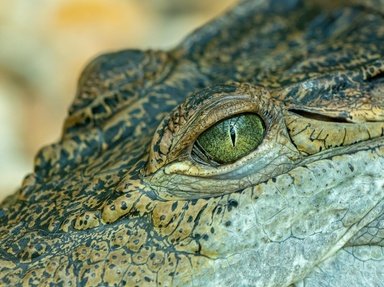Quiz Answer Key and Fun Facts
1. Eager to see the crocs and gators, you demand to first be taken to the biggest reptiles in the Crocoseum. You are taken to an enclosure containing the appropriately named, Big Baban and Massive Mike! You are told that these two are members of the largest species of crocodile. Can you name that species?
2. You notice many protective barriers around the enclosures of the Crocoseum, and after our next crocodile, you'll see why. TCEB the Terrific is known in the Crocoseum as a great performer. Many come to see him leap to great heights out of the water and perform his death rolls. Can you tell me what the main purpose of a death roll is?
3. You now approach the next enclosure in the Australian Crocoseum. The sign reads "Say hello to Exit and Madkeen." You are told that they are locals (i.e. from Australia), but you are not told what species they are. What species are Exit and Madkeen most likely to be?
4. Next in the Crocoseum you come to Alex and Alifin, the alligators. You are told that there are only two species of alligator - the Chinese and the American. Alex and Alifin belong to the latter species. In which US national park are these gators commonly found?
5. Still touring the Crocoseum, you come to the next display. The star of this show is Sierot the sarcosuchus. However, he is slightly different than the others you have seen so far. How?
6. MIMO the Siamese croc is the inhabitant of the Crocoseum's next enclosure. Siamese crocodiles are fairly easy going, enjoying slow waters and eating just about anything. Although MIMO has a very broad palate, which food would he mostly eat in the wild?
7. Feisty Flopsy is next on our tour of the Crocoseum. Flopsy is a Nile crocodile and she uses her cone-shaped teeth to grip prey and tear off chunks of meat. In her feisty attempts to gain a meal, Flopsy may occasionally break a tooth. Tell me, is she able to re-grow the teeth she loses?
8. The people at the Crocoseum are very excited today, as there are some new hatchlings in our next enclosure. Who better to teach them the ways of life than our next crocodile, their mother, Jabberwok? Most baby crocs can break their way out of an egg, but if one was not able to, how would Jabberwok react?
9. We come to our next enclosure in the Crocoseum to see Gary and Glenda, the gharials. These are certainly two impressive looking creatures. What makes these two crocodilians so different to the others you have seen so far?
10. Our next crocodile was found in a city, eating domesticated pets! This has led to him gaining the nickname, "Terrible Tim." The people at the Crocoseum would like to know how old this new edition is. They say that they can tell his age by counting the number of rings on small bony plates on his back. What are these boney plates usually known as?
Source: Author
doublemm
This quiz was reviewed by FunTrivia editor
crisw before going online.
Any errors found in FunTrivia content are routinely corrected through our feedback system.

